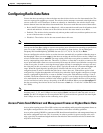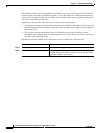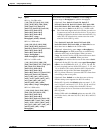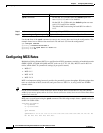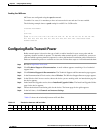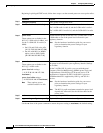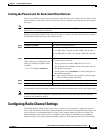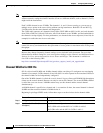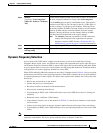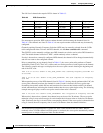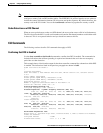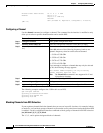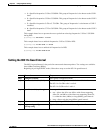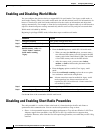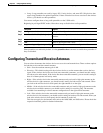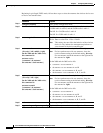
6-17
Cisco IOS Software Configuration Guide for Cisco Aironet Access Points
OL-30644-01
Chapter 6 Configuring Radio Settings
Configuring Radio Channel Settings
Dynamic Frequency Selection
Access points with 5-GHz radios configured at the factory for use in the United States, Europe,
Singapore, Korea, Japan, Israel, and Taiwan now comply with regulations that require radio devices to
use Dynamic Frequency Selection (DFS) to detect radar signals and avoid interfering with them. When
an access points detects a radar on a certain channel, it avoids using that channel for 30 minutes. Radios
configured for use in other regulatory domains do not use DFS.
When a DFS-enabled 5-GHz radio operates on one of the 15 channels listed in Table 6-3, the access point
automatically uses DFS to set the operating frequency. When DFS is enabled, the access point monitors
its operating frequency for radar signals. If it detects radar signals on the channel, the access point takes
these steps:
• Blocks new transmissions on the channel.
• Flushes the power-save client queues.
• Broadcasts an 802.11h channel-switch announcement.
• Disassociates remaining client devices.
• If participating in WDS, sends a DFS notification to the active WDS device that it is leaving the
frequency.
• Randomly selects a different 5-GHz channel.
• If the channel selected is one of the channels in Table 6-3, scans the new channel for radar signals
for 60 seconds.
• If there are no radar signals on the new channel, enables beacons and accepts client associations.
• If participating in WDS, sends a DFS notification of its new operating frequency to the active WDS
device.
Note You cannot manually select a channel for DFS-enabled 5-GHz radios in some regions, depending on the
regulatory requirements. The access points randomly selects a channel in that case.
Step 3
channel
{frequency | least-congested |
width [20 | 40-above | 40-below]
| dfs}
Set the default channel for the wireless device radio. To search for
the least-congested channel on startup, enter least-congested.
Use the width option to specify a bandwidth to use. This option is
available on all 802.11n APs, but only for the d1 (5 GHz) radio. It
has three settings: 20, 40-above, and 40-below. Choosing 20 sets
the channel width to 20 MHz. Choosing 40-above sets the channel
width to 40 Mhz with the extension channel above the control
channel. Choosing 40-below sets the channel width to 40 MHz
with the extension channel below the control channel.
Note The channel command is disabled for 5-GHz radios that
comply with European Union regulations on dynamic
frequency selection (DFS). See the “Setting the 802.11n
Guard Interval” section on page 6-21 for more information.
Step 4
end Return to privileged EXEC mode.
Step 5
copy running-config
startup-config
(Optional) Save your entries in the configuration file.
Command Purpose



